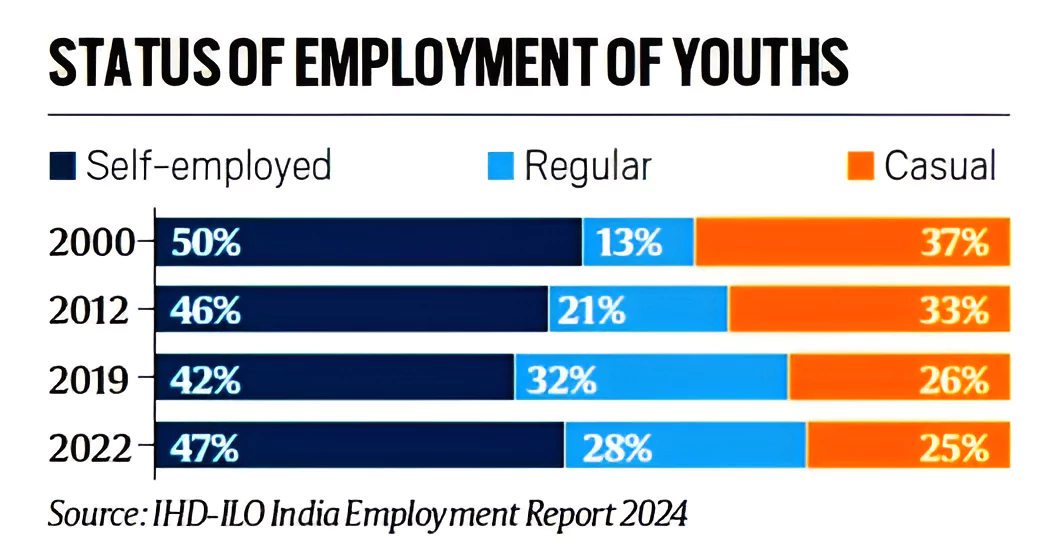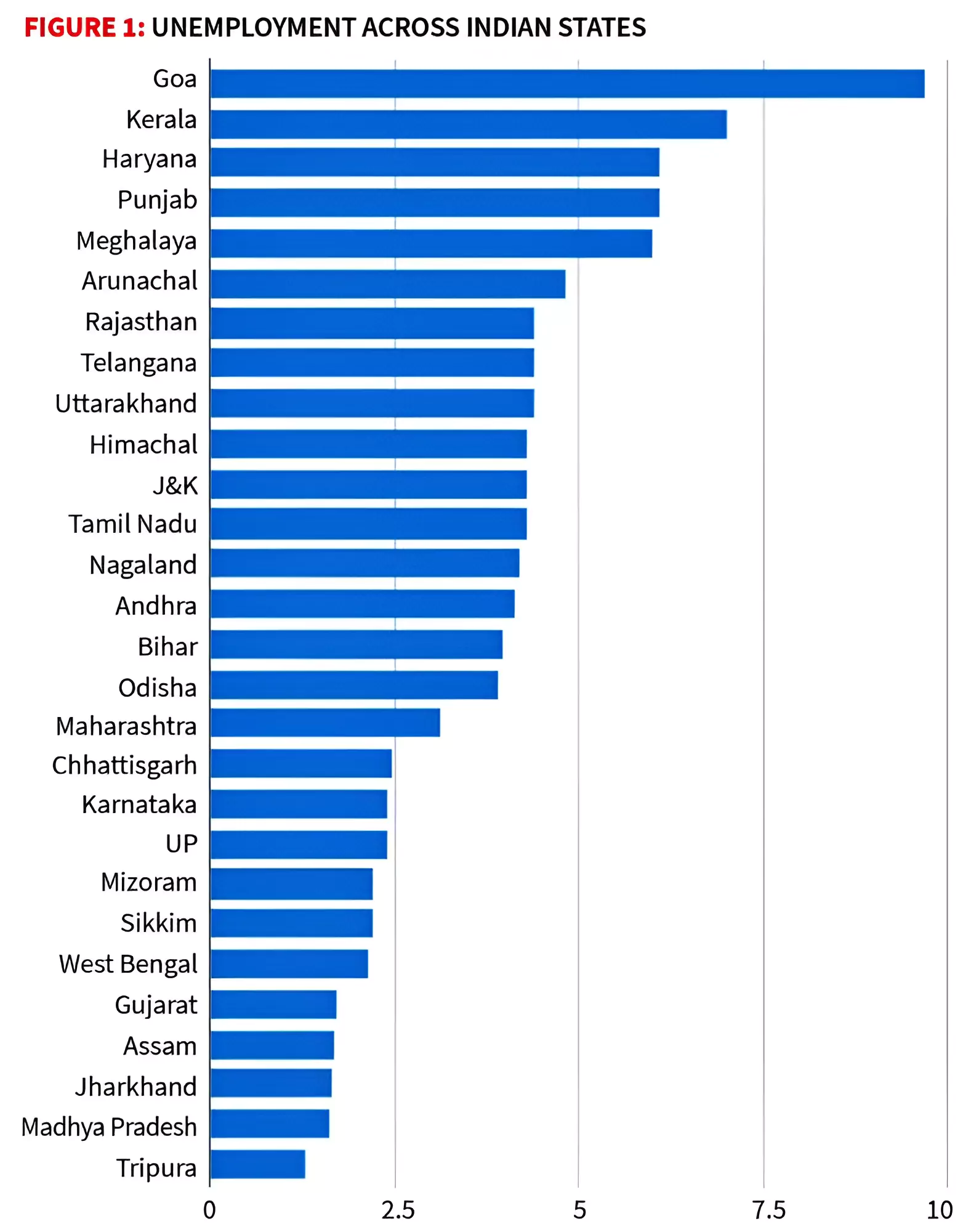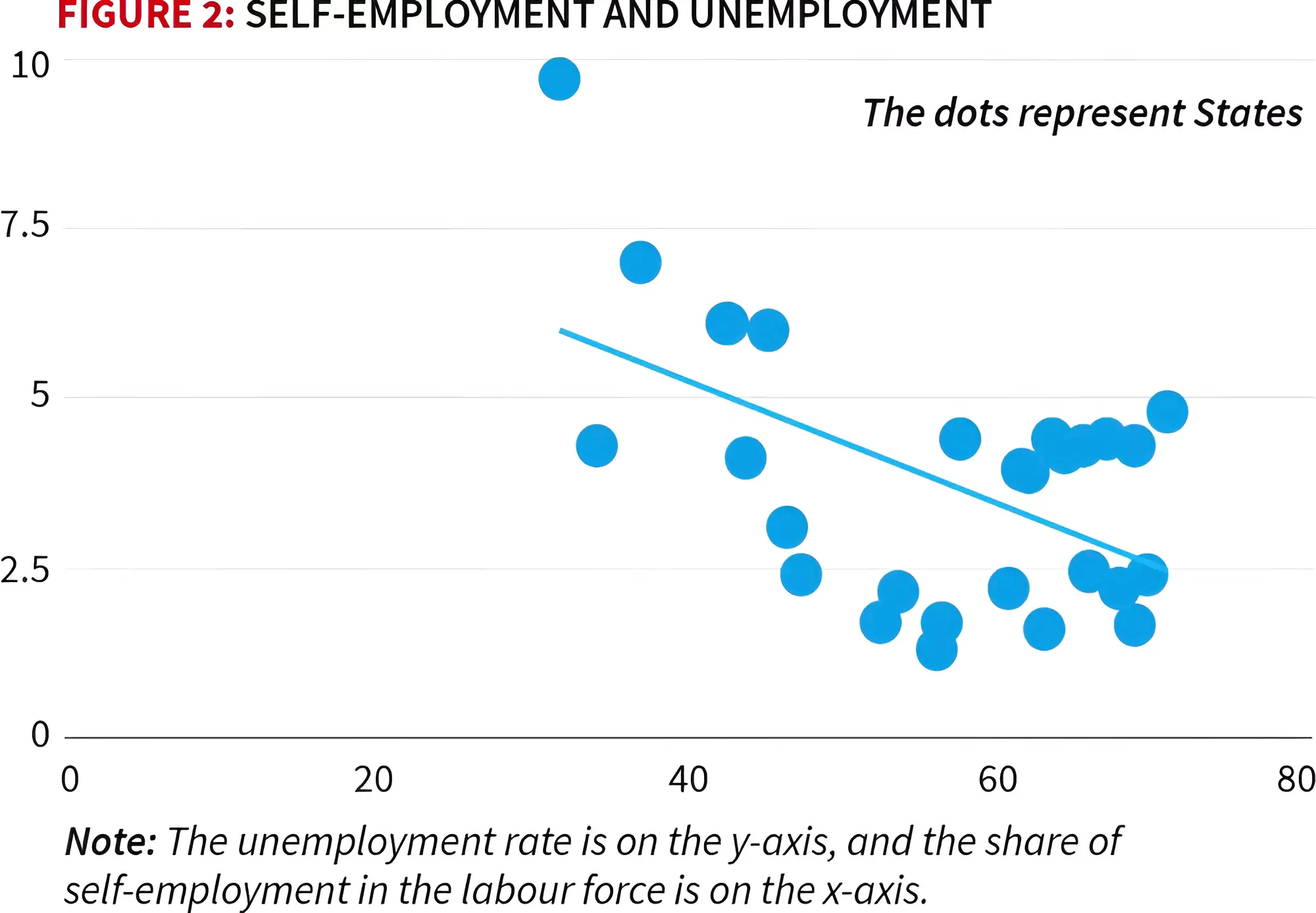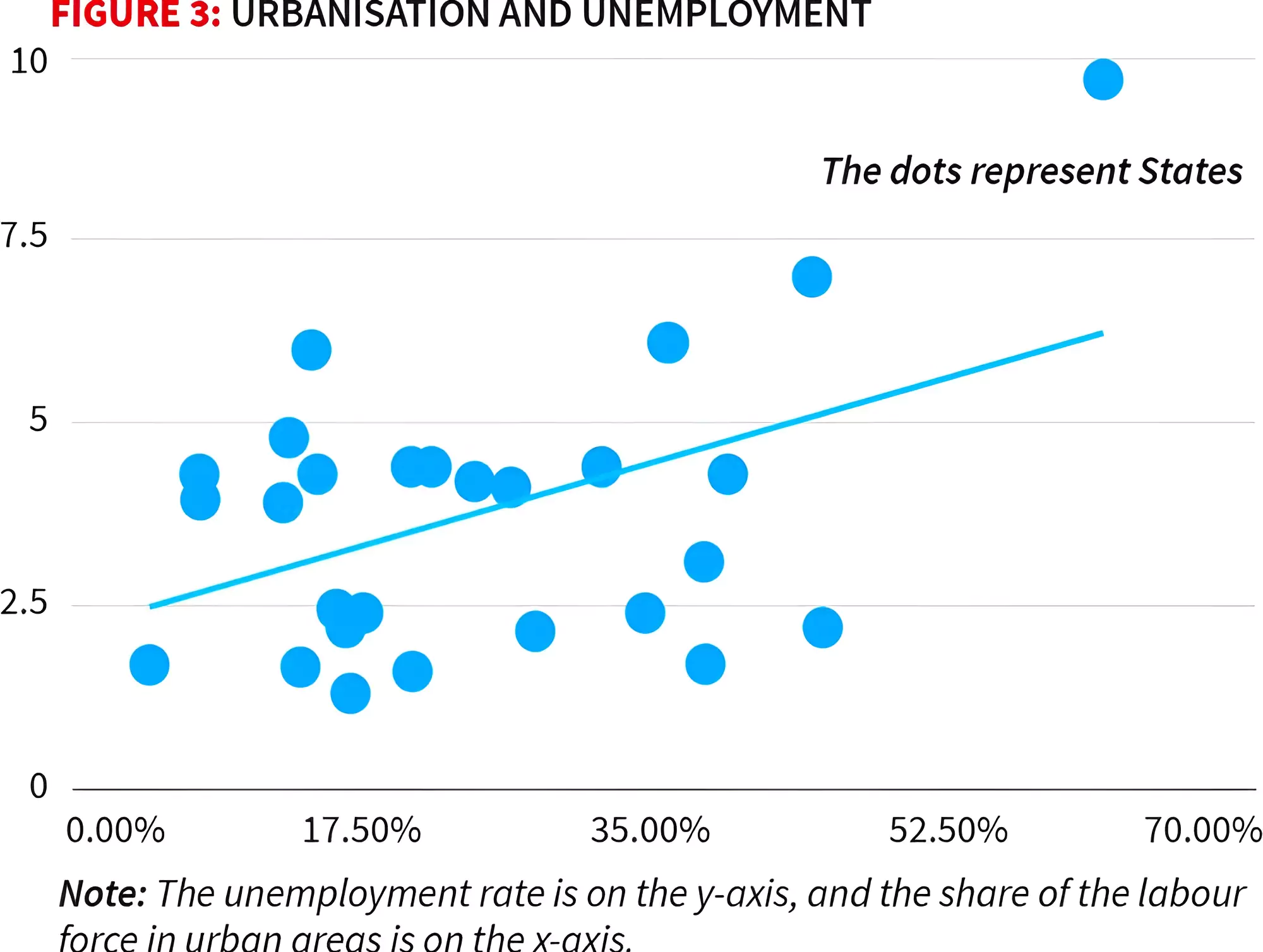Context
Recently, the ‘India Employment Report 2024’ has been released by the Institute for Human Development (IHD) and International Labour Organisation (ILO).
About Unemployment
- The International Labour Organization (ILO) defines unemployment as being out of a job; being available to take a job; and actively engaged in searching for work.
- The National Sample Survey Organisation (NSSO) adopts two major measures for classifying the working status of individuals in India — the Usual Principal and Subsidiary Status (UPSS) and the Current Weekly Status (CWS).
Calculation of Unemployment Rate in India
- Unemployment Rate = Number of Unemployed Persons / Civilian Labor Force
Or,
- Unemployment Rate = Number of Unemployed Persons / (Number of Employed Persons + Number of Unemployed Persons)
|
Crucial Insights of the India Employment Report 2024
-
On Employment Quality:
- Rise in Informal Employment: It has risen, around half the jobs in the formal sector are of an informal nature.
- Self-employment and unpaid family work has also increased, especially for women.
- Almost 82% of the workforce is engaged in the informal sector, and nearly 90% is informally employed.
- Preference: Regular employment is generally seen as providing better-quality jobs due to the regularity of employment and associated social security benefits, while casual work is linked with relatively poor-quality jobs due to its irregular nature and lower daily earnings.
- Self-employment remains the primary source of employment (55.8% in 2022). Casual and regular employment accounted for 22.7% and 21.5% respectively.
Enroll now for UPSC Online Course
-
Structural Transformation:
- Non-farm Employment: There has been a reversal of the slow transition towards non-farm employment after 2018-19. The share of agriculture in total employment fell to around 42% in 2019 from 60% in 2000.
- Employment in Secondary & Tertiary Sectors: The non-farm shift was largely absorbed by construction and services, the share of which in total employment increased to 32% in 2019 from 23% in 2000. The share of manufacturing in employment has remained almost stagnant at 12-14%.
-
On Education & Employment:
- Kerala has a highly educated labour force (30% of the labour force are graduates) and faces high unemployment.
- Gujarat and Maharashtra have a relatively lower share of graduates in their labour force (roughly 14% and 20% respectively) and hence have lower unemployment in spite of being richer and urbanised.
- Probable Factors: Mismatching and lacking in required skills, high aspirations by graduates seeking high-wage and inadequate state policy.

-
- Poor Conditions: There has been a rise in youth employment, but the quality of work remains a concern, especially for qualified young workers.
- Example: In 2022, the share of unemployed youths in the total unemployed population was 82.9%.
- However, youth employment and underemployment increased between 2000 and 2019 but declined during the pandemic years.
- Unemployment Rate among Educated Youths: Unemployment among youths, especially those with secondary-level or higher education, has intensified over time.
- Example: The unemployment rate among youths was six times higher for those who had completed secondary education or higher (18.4%) and nine times higher for graduates (29.1%) than for persons who could not read or write (3.4%) in 2022.
- In 2022, the proportion of youths not in employment, education, or training remained high, at 28.5%.
-
Participation of Women:
-
- Low Count: The female labour force participation rate (LFPR) in India remains among the world’s lowest.
- Female LFPR declined by 14.4% points (compared to 8.1% points for males) between 2000 and 2019. But, the trend reversed thereafter, with female LFPR rising by 8.3% points (compared to 1.7% points for male LFPR) between 2019 and 2022.
About Labour Force:
- The labour force is defined as the sum of the employed and the unemployed.
- Those neither employed nor unemployed such as students and those engaged in unpaid domestic work are considered out of the labour force.
|
-
- Widening Gender Gap: Women’s LFPR (32.8%) in 2022 was 2.3 times lower than men’s (77.2%).
- India’s low LFPR is largely due to the low female LFPR, which was much lower than the world average of 47.3% in 2022, but higher than the South Asian average of 24.8%.
- Unemployment Rate among Educated Women Youths: This was higher among educated young women (21.4%) than men (17.5%), especially among female graduates (34.5%), compared to men (26.4%).
- Among the educated (secondary level or higher) unemployed youths, women accounted for a larger share (76.7%) than men (62.2%).
Enroll now for UPSC Online Classes
-
Growing Social Inequalities:
-
- Scheduled Castes and Scheduled Tribes have greater participation in work due to economic necessity but engaged more in low-paid temporary casual wage work and informal employment.
- Despite improvement in educational attainment among all groups, the hierarchy within social groups persists.
Unemployment in Indian States- A Regional Difference
- Basis: Among individuals aged 15 and above as measured by the Usual Principal and Subsidiary Status (UPSS), utilising data from the Periodic Labour Force Survey (PLFS) of 2022-23. Coverage: This analysis looks at unemployment in the major States of India (excluding the Union Territories).
- Manipur is not included since field work was not completed owing to the conflict.
| Usual Principal and Subsidiary Status (UPSS): It determines a person’s employment status based on their engagement for a substantial period (over 182 days) in one or more work-related activities during the 365 days preceding the survey. |
- Findings: Out of the 27 States considered, 12 States have unemployment rates less than the national average (3.17%).
- Low unemployment rates in larger States (3% in Maharashtra, 2.4% in Uttar Pradesh and 1.6% in Madhya Pradesh) bring down the national average.
 But this presents a conundrum, barring Maharashtra and Gujarat, many States with unemployment rates lower than the national average also have per capita incomes lesser than the national average.
But this presents a conundrum, barring Maharashtra and Gujarat, many States with unemployment rates lower than the national average also have per capita incomes lesser than the national average.
- An Indicator, not a Measurement: Since the coverage of smaller States in the overall sample is less compared to larger States, these estimates should not be taken as definitive measurements but as indicators of the important factors driving unemployment.
- Regional Disparities:
- Goa has the highest unemployment rate (almost 10%) and is more than three times the national average (3.17%).
- Interestingly, 4 of the top 5 Unemployment facing States (Goa, Kerala, Haryana and Punjab) are comparatively richer states.
- All northern States (Jammu and Kashmir, Punjab, Haryana, Uttarakhand and Himachal Pradesh) have unemployment rates higher than the national average, as do all southern States with the exception of Karnataka.
- The rich States of western India (Maharashtra and Gujarat) experience unemployment rates far less than the national average.

The Determinants of Unemployment
- Relationship between Unemployment Rates and the Share of the Labour Force in Self-employment: In States where a large proportion of the labour force is engaged in self-employment, the unemployment rate is low.
- Since a bulk of the self-employment in India is of the informal variety, States with a large proportion of informal work would find it easy to absorb a large number of job-seekers.
- Yet it is unclear whether this relationship is cause or effect.
 Informal Self-employment Sector: A large proportion of informal self-employment is accounted for by agriculture and the rural economy.
Informal Self-employment Sector: A large proportion of informal self-employment is accounted for by agriculture and the rural economy.-
- Urbanised States have smaller agrarian and agrarian-dependent sectors and hence have a relatively smaller source of informal jobs available.
- While informal sectors do exist and thrive in urban settings, the scope for the absorption of job-seekers is limited as compared to rural agriculture, which often acts as a ‘reserve’ absorbing surplus labour.
Causes of Unemployment in India
- Various Factors: Unemployment in India is influenced by diverse factors such as demographic challenges, economic differences in rural and urban areas, limited job creation, high youth unemployment, gender economic divide, the informal sector, and skill-job mismatch, etc.
Enroll now for UPSC Online Course
Concerns Associated with High Unemployment in India
- Poor Employment Conditions in India: Even as overall labour force participation, workforce participation and employment rates improved in India in recent years after showing long-term deterioration during 2000-2019, the employment conditions remain poor.
- Challenging Conditions for Youth & Women: Two out of every three unemployed individuals was a young graduate and women largely account for the increase in self-employment and unpaid family work.
- Youth employment is of poorer quality than employment for adults, with a higher proportion of unpaid family work among youth than adults along with stagnant or declining wages and earnings.
- Challenges for Gig Workers: The lack of job security, irregular wages, and uncertain employment status for workers pose significant challenges for gig or platform work.
- Impact of Artificial Intelligence (AI): The rise of AI could have an impact on employment, the outsourcing industry in India could be disrupted because some back-office tasks would be taken over by AI.
- Deepening Regional Disparities: The ‘employment condition index’ has improved between 2004-05 and 2021-22. But some states (Bihar, Odisha, Jharkhand, and UP) have remained at the bottom throughout this period, while some others (Delhi, Himachal Pradesh, Telangana, Uttarakhand, and Gujarat) have stayed at the top.
- Social Inequalities: As per the report, despite affirmative action and targeted policies, the Scheduled Castes and Scheduled Tribes still lag in terms of access to better jobs.
- High Population Size: India’s rising population provides competition for employment opportunities and puts additional pressure on the job market.
Indicators Used in Employment Condition Index:
- The index is based on seven labour market outcome indicators: (i) percentage of workers employed in regular formal work; (ii) percentage of casual labourers; (iii) percentage of self-employed workers below the poverty line; (iv) work participation rate; (v) average monthly earnings of casual labourers; (vi) unemployment rate of secondary and above-educated youth; (vii) youth not in employment and education or training.
|
- Skills Mismatch: With increasing use of technology and AI, skill mismatch presents one of the predominant causes for unemployment in India.
- Dependency on Agriculture: As per Food and Agriculture Organization (FAO), agriculture, with its allied sectors, is the largest source of livelihoods in India.
- 70% of its rural households still depend primarily on agriculture for their livelihood.
- External Factors: Influences from the global economy, such as trade dynamics and geopolitical shifts, can impact India’s employment scenario.
Way Forward to the Increase Employment Opportunities
- Call for Action: There are five key policy areas for further action- promoting job creation, improving employment quality, addressing labour market inequalities, strengthening skills and active labour market policies, and bridging the knowledge deficits on labour market patterns and youth employment.
- Support to Enterprises: More support needs to be provided to micro, small and medium-sized enterprises, especially by providing tools such as digitalisation and AI and a cluster-based approach to manufacturing.
- Collaborative Approach: A larger and more targeted role for state governments and stronger partnerships with the private sector and other stakeholders is also needed, along with greater contribution by the private and non-state sector.
- Harnessing the potential of Digitalisation & Technology: Initiatives such as promoting digital literacy, supporting digital platforms for gig economy work, and fostering technology-driven sectors like e-commerce and fintech can create jobs and empower a digitally skilled workforce.
- Strengthening Education & Industry Collaboration: Collaboration between educational institutions and industries can lead to the development of curriculum aligned with industry needs, internship programs, and vocational training tie-ups.
- This would equip students with practical skills and improve their employability.
- Promoting Skill Development & Vocational Training: Investing in skill development and vocational training is crucial to enhance employability. It would equip individuals with industry-relevant skills, making them more employable.
- Encouraging Entrepreneurship & Startups: Promoting entrepreneurship can create new job opportunities and stimulate economic growth.
- The government can establish incubation centres, provide financial incentives, and simplify regulatory procedures for startups. It will generate employment and foster a culture of self-reliance.
- Policy Interventions: Economic policies are required to boost productive non-farm employment, especially in the manufacturing sector, with India likely to add 7-8 million youths annually to the labour force during the next decade.
- With a higher rate of urbanisation and migration expected in India, an inclusive urban policy is required to address the needs of migrants, women and impoverished young people.
- Skills development and active labour market policies (ALMPs) need a more effective role in bridging the supply-demand gap in jobs and in making the overall labour market more inclusive.
- Recently, the government has fast-tracked the proposed National Employment Policy (NEP), which aims at formalisation of the country’s 500 million workforce including migrants to ensure job and social security.
Enroll now for UPSC Online Classes
Initiatives Taken by the Government
- Support for Marginalised Individuals for Livelihood and Enterprise (SMILE)
- PM-DAKSH (Pradhan Mantri Dakshta Aur Kushalta Sampann Hitgrahi)
- Mahatma Gandhi National Rural Employment Guarantee Act (MGNREGA)
- Pradhan Mantri Kaushal Vikas Yojana (PMKVY)
- Start Up India Scheme
- Rozgar Mela
- Government has taken several facilitative actions for employment including skill development initiatives along with National Education Policy (NEP).
- Other government measures for employment include payment of employers’ contribution for new employees under the Employees’ Provident Fund Organisation (EPFO), Atmanirbhar Bharat Rozgar Yojana; and the new tax regime allowing for deductions of wages to employers.
|
Also Read: India Skills Report 2024 And Skill Development In India
| Prelims PYQ (2018):
Consider the following statements: Human capital formation as a concept is better explained in terms of a process which enables
1. individuals of a country to accumulate more capital.
2. increasing the knowledge, skill levels and capacities of the people of the country.
3. accumulation of tangible wealth.
4. accumulation of intangible wealth.
Which of the statements given above is/are correct?
(a) 1 and 2
(b) 2 only
(c) 2 and 4
(d) 1, 3 and 4
Ans: (c) |
![]() 11 Apr 2024
11 Apr 2024


 But this presents a conundrum, barring Maharashtra and Gujarat, many States with unemployment rates lower than the national average also have per capita incomes lesser than the national average.
But this presents a conundrum, barring Maharashtra and Gujarat, many States with unemployment rates lower than the national average also have per capita incomes lesser than the national average.

 Informal Self-employment Sector: A large proportion of informal self-employment is accounted for by agriculture and the rural economy.
Informal Self-employment Sector: A large proportion of informal self-employment is accounted for by agriculture and the rural economy.